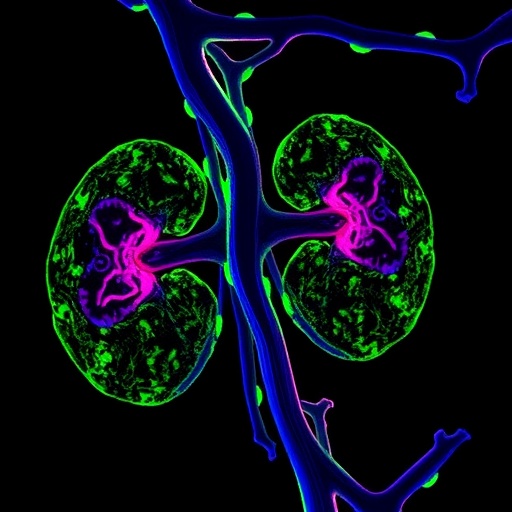In a groundbreaking advancement in the understanding of kidney fibrosis, a recent study published in Cell Death Discovery illuminates the pivotal role of matrix metalloproteinase-10 (MMP-10) in driving fibrotic processes through the activation of β-catenin signaling. Kidney fibrosis, a hallmark of chronic kidney disease (CKD), results in irreversible scarring that ultimately compromises renal function, posing a significant global health challenge. The new research spearheaded by Sun, Ren, Liu, and colleagues provides compelling mechanistic insights that could pave the way for innovative therapeutic strategies aimed at halting or reversing fibrosis progression.
Chronic kidney disease affects millions worldwide and is often marked by progressive fibrosis that obliterates the intricate architecture of healthy renal tissue. Despite decades of research, the molecular pathways that orchestrate fibrosis remain incompletely defined, limiting effective clinical interventions. The current study shines a spotlight on the underappreciated role of MMP-10, a member of the matrix metalloproteinase family, enzymes traditionally known for their extracellular matrix remodeling functions. However, Sun et al. reveal that MMP-10’s impact extends far beyond matrix degradation, implicating it as a crucial mediator in intracellular signaling cascades that foster fibrosis.
Matrix metalloproteinases have long been studied for their dualistic functions; while they aid in normal tissue repair, their dysregulation can provoke pathological remodeling. MMP-10, in particular, has garnered attention for its elevated expression in various fibrotic tissues, yet the mechanisms connecting its activity to fibrosis remained elusive until now. The authors employ comprehensive molecular biology techniques, including gene knockdown and overexpression models, coupled with advanced imaging and transcriptomic analyses, to unravel how MMP-10 initiates crosstalk with β-catenin signaling — a well-characterized pathway known to govern cell proliferation, differentiation, and survival.
The crux of the study lies in the discovery that MMP-10 transactivates β-catenin signaling through proteolytic modification of membrane-bound receptors and intracellular effectors. By modulating the stability and localization of β-catenin, MMP-10 indirectly promotes the transcription of fibrogenic genes, including those encoding extracellular matrix components such as collagen and fibronectin. This aberrant gene expression fosters the activation of myofibroblasts, the key effector cells responsible for the excessive deposition of fibrotic tissue within the kidney interstitium. This chain of molecular events ultimately culminates in the disruption of normal renal function and the progression of disease.
Perhaps most intriguingly, the investigators demonstrate that inhibiting MMP-10 activity attenuates β-catenin signaling and reduces fibrotic markers both in vitro and in vivo. Using murine models of kidney injury, treatment with specific MMP-10 inhibitors resulted in diminished glomerulosclerosis and tubulointerstitial fibrosis, accompanied by improvements in renal function measurements. These findings substantiate MMP-10 not only as a critical pathogenic driver but also as a promising therapeutic target. The study’s translational potential is augmented by the fact that MMP inhibitors have already been developed and trialed in other fibrotic and oncological contexts.
The significance of linking MMP-10 to β-catenin transactivation lies in its challenge to the conventional paradigm that matrix metalloproteinases primarily function through extracellular degradation. This novel signaling axis expands the biological repertoire of MMPs, suggesting an intricate interplay between protease activity and canonical Wnt/β-catenin pathways in fibrosis. Furthermore, it underscores the complexity of fibrotic diseases, where enzymatic activities can have unexpected intracellular consequences that perpetuate tissue damage.
Kidney fibrosis remains a final common pathway leading to end-stage renal disease irrespective of the initial insult, be it diabetic nephropathy, hypertensive nephrosclerosis, or autoimmune nephritis. Thus, new insights like those provided by Sun and colleagues are critical for developing comprehensive antifibrotic therapies. Targeting MMP-10 could disrupt the feed-forward loop that exacerbates β-catenin signaling and fibrogenesis, thereby halting or potentially reversing disease progression before irreversible damage ensues.
Moreover, the study opens avenues for biomarker discovery, as elevated MMP-10 levels in serum or urine might serve as early indicators of fibrotic activity. Non-invasive molecular diagnostics incorporating MMP-10 assessment could enable clinicians to identify high-risk patients and tailor personalized interventions. Coupled with β-catenin activity profiling, such biomarkers could enhance prognostic precision and therapeutic monitoring in CKD management.
From a broader perspective, the elucidation of MMP-10’s role in kidney fibrosis may stimulate investigation into its involvement in other fibrotic pathologies, such as pulmonary fibrosis, liver cirrhosis, and cardiac fibrosis. Given the shared molecular pathways across different organs, therapeutic strategies targeting MMP-10 might hold wide applicability, heralding a new class of antifibrotic drugs with systemic benefits. Future research is warranted to explore the tissue-specific regulation of MMP-10 and its interaction with diverse signaling networks.
The rigorous experimental design employed by the research team lends strong credibility to their conclusions. Multilayered mechanistic dissection involved CRISPR-Cas9-mediated gene editing, proteomic profiling, chromatin immunoprecipitation assays to verify transcriptional regulation, and sophisticated imaging techniques to monitor β-catenin nuclear translocation. These comprehensive methodologies ensured that the role of MMP-10 was examined from multiple physiological angles, solidifying its position as a fibrosis driver.
The therapeutic implications extend beyond direct MMP-10 inhibition; understanding how MMP-10 interacts with β-catenin pathways presents opportunities for combination therapies. For instance, synergistic targeting of both MMP-10 activity and downstream β-catenin-mediated transcription might provide enhanced antifibrotic efficacy. Additionally, modulating upstream regulators that control MMP-10 expression could offer preventative strategies against fibrosis initiation.
Importantly, this research underscores the critical need to move beyond symptomatic treatment of CKD and toward molecularly targeted interventions. Fibrosis reversal has long been considered a challenging prospect, but studies like this inject renewed optimism that precise inhibition of molecular drivers like MMP-10 can not only stall disease progression but potentially restore renal architecture and function.
Subject of Research: Kidney fibrosis; molecular mechanisms of fibrosis; matrix metalloproteinase-10 (MMP-10); β-catenin signaling.
Article Title: Matrix metalloproteinase-10 promotes kidney fibrosis by transactivating β-catenin signaling.
Article References:
Sun, X., Ren, Q., Liu, X. et al. Matrix metalloproteinase-10 promotes kidney fibrosis by transactivating β-catenin signaling. Cell Death Discov. 11, 241 (2025). https://doi.org/10.1038/s41420-025-02521-w
Image Credits: AI Generated
DOI: https://doi.org/10.1038/s41420-025-02521-w
Tags: chronic kidney disease global health challengeextracellular matrix remodeling in kidney diseaseimplications of MMP-10 dysregulationinnovative interventions for kidney fibrosismatrix metalloproteinase-10 in kidney fibrosismechanisms of kidney fibrosis progressionMMP-10 as a fibrotic mediatorresearch advancements in renal fibrosisrole of MMP-10 in renal scarringsignaling pathways in kidney fibrosistherapeutic strategies for chronic kidney diseaseβ-catenin signaling in chronic kidney disease





